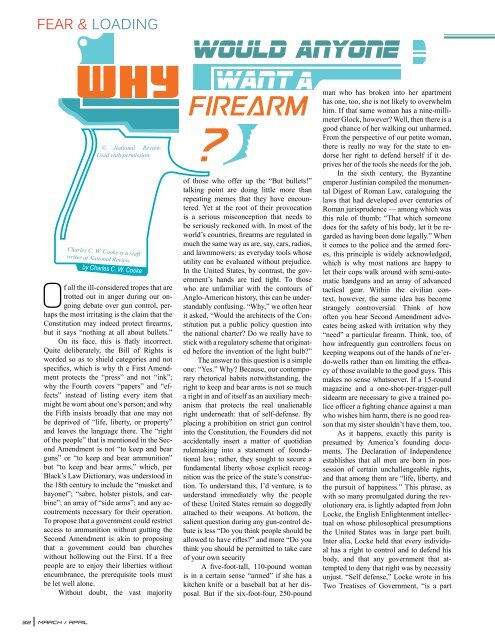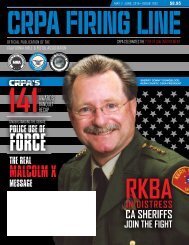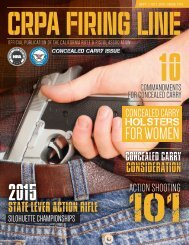Create successful ePaper yourself
Turn your PDF publications into a flip-book with our unique Google optimized e-Paper software.
FEAR & LOADING<br />
Why Firearm<br />
?<br />
© National Review.<br />
Used with permission.<br />
Charles C. W. Cooke is a staff<br />
writer at National Review.<br />
by Charles C. W. Cooke<br />
Of all the ill-considered tropes that are<br />
trotted out in anger during our ongoing<br />
debate over gun control, perhaps<br />
the most irritating is the claim that the<br />
Constitution may indeed protect firearms,<br />
but it says “nothing at all about bullets.”<br />
On its face, this is flatly incorrect.<br />
Quite deliberately, the Bill of Rights is<br />
worded so as to shield categories and not<br />
specifics, which is why th e First Amendment<br />
protects the “press” and not “ink”;<br />
why the Fourth covers “papers” and “effects”<br />
instead of listing every item that<br />
might be worn about one’s person; and why<br />
the Fifth insists broadly that one may not<br />
be deprived of “life, liberty, or property”<br />
and leaves the language there. The “right<br />
of the people” that is mentioned in the Second<br />
Amendment is not “to keep and bear<br />
guns” or “to keep and bear ammunition”<br />
but “to keep and bear arms,” which, per<br />
Black’s Law Dictionary, was understood in<br />
the 18th century to include the “musket and<br />
bayonet”; “sabre, holster pistols, and carbine”;<br />
an array of “side arms”; and any accoutrements<br />
necessary for their operation.<br />
To propose that a government could restrict<br />
access to ammunition without gutting the<br />
Second Amendment is akin to proposing<br />
that a government could ban churches<br />
without hollowing out the First. If a free<br />
people are to enjoy their liberties without<br />
encumbrance, the prerequisite tools must<br />
be let well alone.<br />
Without doubt, the vast majority<br />
of those who offer up the “But bullets!”<br />
talking point are doing little more than<br />
repeating memes that they have encountered.<br />
Yet at the root of their provocation<br />
is a serious misconception that needs to<br />
be seriously reckoned with. In most of the<br />
world’s countries, firearms are regulated in<br />
much the same way as are, say, cars, radios,<br />
and lawnmowers: as everyday tools whose<br />
utility can be evaluated without prejudice.<br />
In the United States, by contrast, the government’s<br />
hands are tied tight. To those<br />
who are unfamiliar with the contours of<br />
Anglo-American history, this can be understandably<br />
confusing. “Why,” we often hear<br />
it asked, “Would the architects of the Constitution<br />
put a public policy question into<br />
the national charter? Do we really have to<br />
stick with a regulatory scheme that originated<br />
before the invention of the light bulb?”<br />
The answer to this question is a simple<br />
one: “Yes.” Why? Because, our contemporary<br />
rhetorical habits notwithstanding, the<br />
right to keep and bear arms is not so much<br />
a right in and of itself as an auxiliary mechanism<br />
that protects the real unalienable<br />
right underneath: that of self-defense. By<br />
placing a prohibition on strict gun control<br />
into the Constitution, the Founders did not<br />
accidentally insert a matter of quotidian<br />
rulemaking into a statement of foundational<br />
law; rather, they sought to secure a<br />
fundamental liberty whose explicit recognition<br />
was the price of the state’s construction.<br />
To understand this, I’d venture, is to<br />
understand immediately why the people<br />
of these United States remain so doggedly<br />
attached to their weapons. At bottom, the<br />
salient question during any gun-control debate<br />
is less “Do you think people should be<br />
allowed to have rifles?” and more “Do you<br />
think you should be permitted to take care<br />
of your own security<br />
A five-foot-tall, 110-pound woman<br />
is in a certain sense “armed” if she has a<br />
kitchen knife or a baseball bat at her disposal.<br />
But if the six-foot-four, 250-pound<br />
man who has broken into her apartment<br />
has one, too, she is not likely to overwhelm<br />
him. If that same woman has a nine-millimeter<br />
Glock, however? Well, then there is a<br />
good chance of her walking out unharmed.<br />
From the perspective of our petite woman,<br />
there is really no way for the state to endorse<br />
her right to defend herself if it deprives<br />
her of the tools she needs for the job.<br />
In the sixth century, the Byzantine<br />
emperor Justinian compiled the monumental<br />
Digest of Roman Law, cataloguing the<br />
laws that had developed over centuries of<br />
Roman jurisprudence — among which was<br />
this rule of thumb: “That which someone<br />
does for the safety of his body, let it be regarded<br />
as having been done legally.” When<br />
it comes to the police and the armed forces,<br />
this principle is widely acknowledged,<br />
which is why most nations are happy to<br />
let their cops walk around with semi-automatic<br />
handguns and an array of advanced<br />
tactical gear. Within the civilian context,<br />
however, the same idea has become<br />
strangely controversial. Think of how<br />
often you hear Second Amendment advocates<br />
being asked with irritation why they<br />
“need” a particular firearm. Think, too, of<br />
how infrequently gun controllers focus on<br />
keeping weapons out of the hands of ne’erdo-wells<br />
rather than on limiting the efficacy<br />
of those available to the good guys. This<br />
makes no sense whatsoever. If a 15-round<br />
magazine and a one-shot-per-trigger-pull<br />
sidearm are necessary to give a trained police<br />
officer a fighting chance against a man<br />
who wishes him harm, there is no good reason<br />
that my sister shouldn’t have them, too.<br />
As it happens, exactly this parity is<br />
presumed by America’s founding documents.<br />
The Declaration of Independence<br />
establishes that all men are born in possession<br />
of certain unchallengeable rights,<br />
and that among them are “life, liberty, and<br />
the pursuit of happiness.” This phrase, as<br />
with so many promulgated during the revolutionary<br />
era, is lightly adapted from John<br />
Locke, the English Enlightenment intellectual<br />
on whose philosophical presumptions<br />
the United States was in large part built.<br />
Inter alia, Locke held that every individual<br />
has a right to control and to defend his<br />
body, and that any government that attempted<br />
to deny that right was by necessity<br />
unjust. “Self defense,” Locke wrote in his<br />
Two Treatises of Government, “is a part<br />
32<br />
MARCH / APRIL








